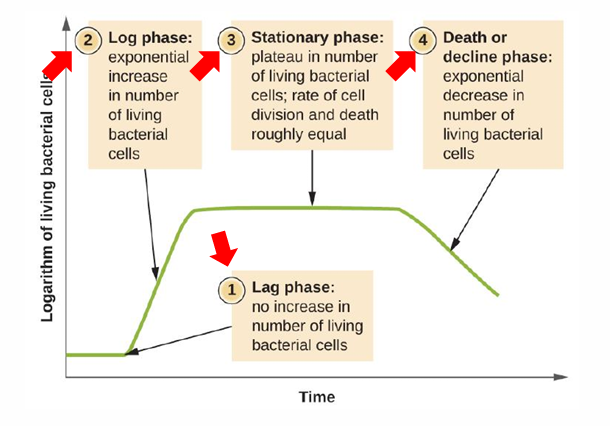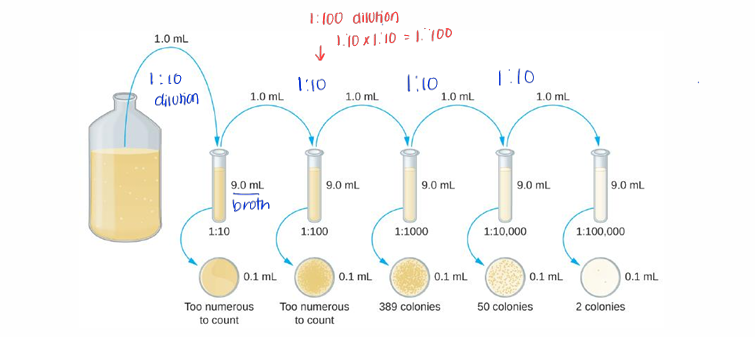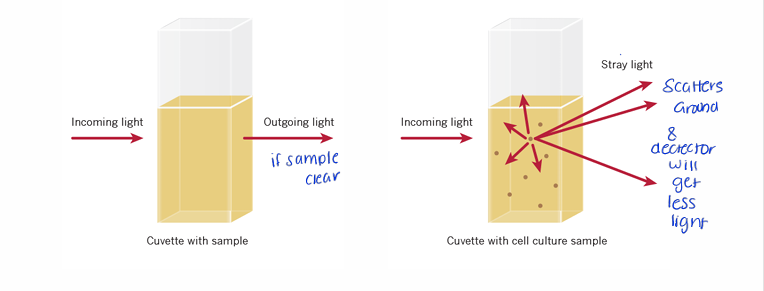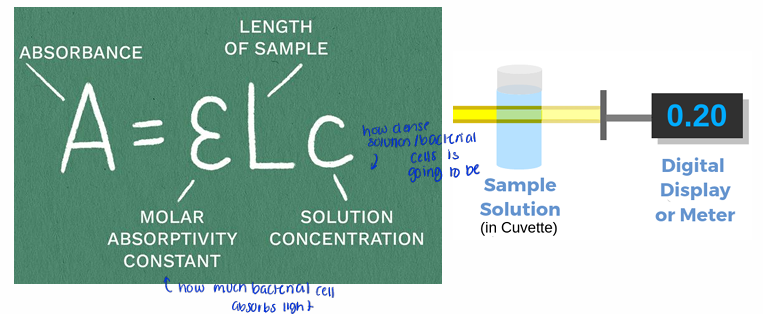Friday July 5th
1/31
There's no tags or description
Looks like no tags are added yet.
Name | Mastery | Learn | Test | Matching | Spaced |
|---|
No study sessions yet.
32 Terms
What process do bacteria us to exponentially grow under optimal conditions?
Binary Fission
For each generation of bacteria, how many times do bacteria grow?
double in size
Describe the Process of Binary Fission
Asexual Reproduction
Step 1: Duplicate DNA
Step 2: Cytokines and each new organism gets one copy of DNA
Generation Time
Average time for bacterial population to double
lower generation time = faster growth rate
*cold slows bacterial growth
What is a Semilog Scale
easier to graph bacterial growth
Explain the growth curve using the semilog scale
lag phase: adaption to the environment
log phase: exponential growth, cell population doubles every generation time
stationary phase: waste accumulation, nutrients are gradually used up, cells growing and dying at the same rate
death: toxic waste abundancy, nutrients depleted

How do you measure the number of bacterial cells?
Serial Dilution (#’s more manageable): diluting bacteria with liquid media and plate diluted cells on an agar plate
Used Colony-Forming Unit (CFU) Count: count bacterial colonies from a diluted bacterial sample, then calculate number of bacterial cells in the original sample
How does serial dilution work?
taking 1ml from original solution = 1:10 dilution
taking 2 ml from original solution = 1: 100 dilution (1:10 × 1:10)

Spectrophometer
measure bacterial density using the property of light
the more cloudy a tube is the more cell growth there is
indirect method of measuring bacteria
as cells grow, the culture becomes more turbid (cloudy), measures absorbance (optical density)
can NOT differentiate between living or dead bacteria
How does a spectrometer work?
Sample without bacterial cells (Sample Clear)
incoming light → cell sample → outgoing light linear
Sample with bacterial cells
incoming light → cell sample → light scattering and detector will get less light

Understanding Absorbance: If the ingoing light intensity is = to the outgoing light intensity?
Absorbance = 0
Understanding Absorbance: If the ingoing light intensity is more than the outgoing light intensity?
Absorbance greater than 0
Understanding Absorbance: If the ingoing light intensity is much more than the outgoing light intensity?
Absorbance is much greater than 0
What is absorbance and density relationship?
higher absorbance = higher density
How do you calculate absorbance?
Beers Law

What are bacterial biofilms?
collective of microorganisms in which cells stick together and often to a surface
composed of extracellular polymeric substances (EPS) - mix of polysaccharides, proteins, lipids and dna
Difficult to remove and penetrate
Name the steps for biofilm formation?
Step 1: Planktonic (free floating) attach to the surface- eventually get tired and attach themselves to a surface
Step 2: formation of a monolayer and production of matrix
Step 3: Microcolony formation (multiple layer)
Step 4: Biofilm matures, formed of polysaccharides
Step 5: detachment and reversion to planktonic growth→ new cycle starts
Why is it difficult to remove biofilms with antibiotics?
biofilms have a slimy texture which make it difficult to reach cells deep inside the biofilms →incomplete killing of bacteria
antibiotics only kill the top layer of biofilms
leftover cells from the biofilms can regenerate and form new biofilms
How do biofilms form on medical implants?
implants can be contaminated by the microorganisms (planktonic) which can lead to colonies of bacteria that spread to other parts of the body, usually older individuals do not have a strong immune system→illness
biofilms form on the body from implants and single cells can potentially infect the rest of the body by using the blood circulatory system
How do biofilms cause urinary tract infections?
Biofilms form in the bladder
Free floating bacteria turn into bacterial biofilm
re-occuring cycle of infection - antibiotics - infection not cleared → symptoms reappear after a few days
What are the oxygen requirements for bacterial growth?
obligate aerobes
obligate anaerobe
facultative anaerobes
aerotolerant anaerobes
obligate aerobes
need oxygen to grow
killed by lack of oxygen
obligate anaerobe
bacteria killed by oxygen
faculatative anaerobes
Can do both but prefer oxygen
grow best with oxygen, grow slower without oxygen
aerotolerant anaerobes
grow regardless of oxygen presence or absence
What is the effect of pH in microbrial growth?
Acidophile: grow best in acidic environments with low pH
Neutrophile: grow best in neutral environments
Alkaliphile: grow best in basic environments with high pH
Name the different types of growth media?
defined media
complex media
selective media
differential media
enriched media
selective media
inhibits the growth of a group of organisms
bile salts interfere with the growth of many gram positive bacteria and favor the growth of gram negative bacteria
differential media
distinguishes different types of organisms on a single plate
crystal violet differentiates two types of bacteria
enriched media
promotes the growth of bacteria that are normally hard to grow in lab
ex: lysed blood cells are added to promote bacterial growth in chocolate agar
defined media
exact chemical composition is known
complex media
one or more compositions are known
often contains yeast, meat, plants extract
Contains many nutrients that may support the growth of many organism